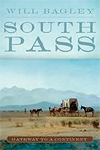
South Pass: Gateway to a Continent, by Will Bagley, University of Oklahoma Press, Norman, 2014, $29.95
South Pass is a rather unremarkable place for those travelers in search of outstanding Western scenery, but that is one of the reasons it came to hold such significance in the settlement of the American West. It was hardly breathtaking, but this high, treeless plain in southwestern Wyoming was a groundbreaking discovery and one of the most significant historic landmarks west of the Mississippi. “Between Marias Pass near the Canadian border and Guadalupe Pass not far from Mexico, South Pass is the only corridor that anything on wheels could use to cross the massive cordillera of the Rocky Mountains without great physical or engineering challenges,” writes Will Bagley, one of the foremost experts on overland emigration, an award-winning author and a contributor to Wild West. American Indians, of course, knew this pass first and probably observed that watercourses on the east side of the pass flowed toward the rising sun, while those west of the pass ran toward the setting sun.
The resourceful Robert Stuart and party left Fort Astoria on the Pacific coast in June 1812 on their way overland to St. Louis. As he traced the future route of the Oregon/California Trail that October, Stuart crossed what became known as South Pass. Stuart understood the significance of this route through the Rockies, but his discovery had no immediate consequences, in part because Americans were preoccupied with the War of 1812 and matters to the east. But in 1824 mountain men Jedediah Smith, Thomas Fitzpatrick and James Clyman rediscovered the historic portal, and in 1832 Captain Benjamin Bonneville brought the first wagons over South Pass. The door was then open for missionaries to cross the Rockies and emigrants to travel to Oregon and California. Bagley notes that between 1840 and 1870 more than a half-million ordinary Americans seeking a better life in the Far West crossed the Continental Divide at South Pass.
Bagley’s work is probably the first book-length study of this significant pass, which allowed wagons to leave the Missouri River and reach the Pacific in a single season. The author provides period perspective from a few of the tens of thousands of people who crossed South Pass during the California Gold Rush and considers the Mormon emigrants’ trying treks (some crossing the Great Plains pushing and pulling handcarts) to their Zion, the Great Salt Lake Valley. Bagley introduces or reintroduces the reader to some interesting Western figures deserving of more recognition, including fur trader Charles Lajeunesse, missionary wives Narcissa Whitman and Eliza Spalding, and “forgotten American hero” Frederick Lander, who transformed the Oregon and California trails into proper overland wagon roads. The Overland Stage, the Pony Express and the first transcontinental telegraph all passed through South Pass, though the first transcontinental railroad, completed in 1869, passed through Wyoming south of South Pass. “The majority of overland emigrants followed the tracks of the Union Pacific across the deserts of southern Wyoming,” Bagley writes, but he adds that the Oregon Trail “saw considerable use by freighters and cattlemen in the last decades of the 19th century.” South Pass looks much the same as it did in 1846. “Its wide-open landscape breathes history,” says Bagley.
—Editor




